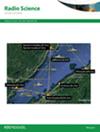第24和25太阳活动周TEC、foF2和hmF2在不同太阳活动条件下的地磁风暴时间响应
IF 1.5
4区 地球科学
Q3 ASTRONOMY & ASTROPHYSICS
引用次数: 0
摘要
本文主要研究了不同太阳活动年不同地磁风暴时间条件下,GPS和digisondes观测数据和IRI- plas模型(IRI - 2016和IRI- plas 2017)获得的TEC、foF2和hmF2在低高纬度地区的变化响应。2014年2月19日、2015年3月17日和2021年11月4日的地磁风暴事件造成了积极的风暴影响(特别是在低纬度地区),而2017年9月8日和2018年8月26日的地磁风暴事件造成了消极的风暴影响,特别是在中高纬度地区。此外,在2014年2月19日风暴期间,在低、中、高纬地区,平均hmF2值分别达到360、282和312 km左右时,观测到日分地线TEC值急剧增加(峰值)。在2018年8月26日的风暴中,在低、中、高纬地区,平均hmF2值分别达到313、258和268 km左右时,TEC值达到峰值。因此,在中纬度地区,迪格松衍生的TEC峰值通常与hmF2的下降相吻合,而在低纬度地区,它与hmF2的增加有关。此外,在太阳活动低期间,当hmF2下降时,观察到digisonde衍生的TEC峰值,与太阳活动高期间的模式形成对比。IRI 2016和IRI- plas 2017模型均表现良好,当hmF2变化值与观测值接近时,可以观测到模型的TEC峰值,增强了模型捕捉地磁风暴期间电离层响应的可靠性。本文章由计算机程序翻译,如有差异,请以英文原文为准。
The geomagnetic storm time responses of the TEC, foF2, and hmF2 in different solar activity during solar cycle 24 and 25
This paper mainly examines the response of variation of the TEC, foF2, and hmF2 obtained from observations (GPS and digisondes) and models (IRI 2016 and IRI-Plas 2017) across low-to-high latitudes during various geomagnetic storm time conditions in different solar activity years. The 19 February 2014, 17 March 2015, and 4 November 2021 geomagnetic storm cases caused positive storm effects (particularly at low latitudes), while the 8 September 2017, and 26 August 2018 geomagnetic storm cases resulted in negative storm effects, especially at mid and high latitudes. Furthermore, during the 19 February 2014 storm, the sharp increase (peak) diurnal digisondes TEC values are observed, on average, when the hmF2 values reach about 360, 282, and 312 km, in the low, mid and high latitudes, respectively. During the 26 August 2018 storm, the peak TEC values are observed, on average, when the hmF2 values reach about 313, 258, and 268 km in the low, mid and high latitudes, respectively. Hence, the digisonde-derived peak TEC in mid latitudes typically coincides with a decrease in hmF2, while in low latitudes, it is associated with an increase in hmF2. Additionally, during low solar activity periods, digisonde-derived peak TEC values were observed when hmF2 decreased, contrasting with patterns seen during high solar activity. Both the IRI 2016 and IRI-Plas 2017 models performed well, with the models peak TEC values being observed when the hmF2 variations attain similar values with the observations, reinforcing the models' reliability in capturing ionospheric responses during geomagnetic storms.
求助全文
通过发布文献求助,成功后即可免费获取论文全文。
去求助
来源期刊

Radio Science
工程技术-地球化学与地球物理
CiteScore
3.30
自引率
12.50%
发文量
112
审稿时长
1 months
期刊介绍:
Radio Science (RDS) publishes original scientific contributions on radio-frequency electromagnetic-propagation and its applications. Contributions covering measurement, modelling, prediction and forecasting techniques pertinent to fields and waves - including antennas, signals and systems, the terrestrial and space environment and radio propagation problems in radio astronomy - are welcome. Contributions may address propagation through, interaction with, and remote sensing of structures, geophysical media, plasmas, and materials, as well as the application of radio frequency electromagnetic techniques to remote sensing of the Earth and other bodies in the solar system.
 求助内容:
求助内容: 应助结果提醒方式:
应助结果提醒方式:


